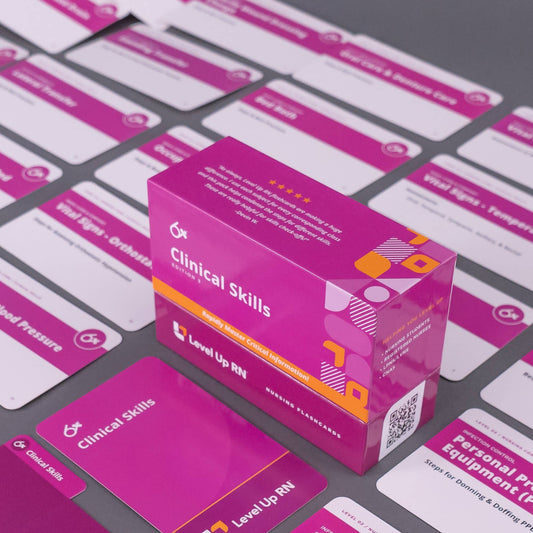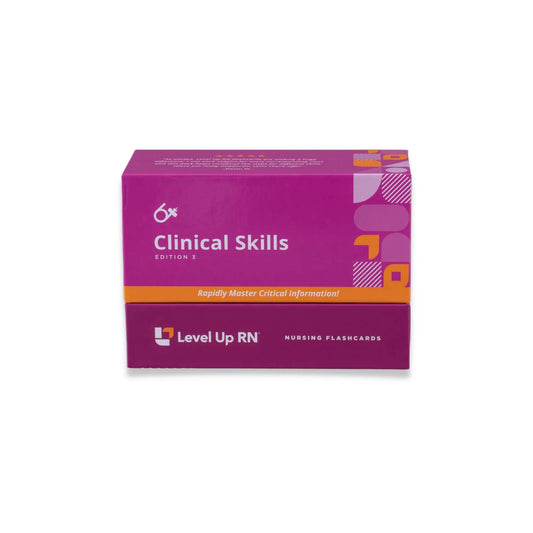Clinical Skills - Occupied Bed Making
Updated: Ellis ParkerHow to complete an occupied bed change. It would be appropriate to wear gloves during this skill to avoid contact with bodily fluids.
Full Transcript: Clinical Skills - Occupied Bed Making
Full Transcript: Clinical Skills - Occupied Bed Making
Hi, I'm Ellis with Level Up RN. In this video, I'll be demonstrating occupied bedmaking. I'll be following the steps that are included in the clinical skills nursing deck. So if you have the deck, grab this card, and you can follow right along with me. If you don't have the deck, you can check it out at leveluprn.com. You'll notice that I have a special guest to assist me in the occupied part of the occupied bedmaking. For the purposes of our video, because I was the only nurse around, we did have her capable of assisting me by doing things like turning. However, there are many situations in which the patient that you're working with during an occupied bed change would not be able to assist you with things like turning, so make sure you always protect yourself by getting at least one other staff member to assist you.
Hi, Ms. Kathy. I'm going to go ahead and change your bed for you this morning. So first, I'm going to raise your bed and lower your head. And because you're not able to get up, we're just going to do an occupied bed change. So I'd like to raise it to working height, which is about the level of my waist. I'm going to lower you all the way down as long as that's okay with you. So if you don't mind, I'm going to have you go ahead and roll over to that side of the bed and just grab onto that side rail to keep yourself on your side.
I've already prepared my set of clean linens, and these linens include the full bed set. I like to stack my linens in the order of which they'll be used. So the one on top is going to be my flat sheet, my fitted sheet. All right. I'm going to remove the pillow from under your head. I'm going to set it on a clean surface. I'm going to just uncover her back, and then I'm going to take her fitted sheet, and if she has a pad or any kind of other sheet under her, that as well, and I'm going to just roll it up under her. I like to push down onto the bed and push under my patient to get it under them, and once I feel like it's pushed over as far as it can be pushed over, I'll get that clean fitted sheet, and I'll put that on the clean side of the bed. Now, if my bed is damp or soiled in any way, I would, of course, use something like a cavity wipe to wipe it down first and then maybe a towel to dry it. Are you doing okay, Ms. Kathy?
I've got my fitted sheet down. Then I'll also go ahead and put my pad down. So I like to make sure that I've got it in a way that it should be centered under their bottom after we roll them back over. I'm going to accordion style fold this. I'm going to wrap it in my clean fitted sheet and hopefully push down and tuck it under the dirty fitted sheet. All right. Now, Ms. Kathy, I want you to roll back towards me and grab this side rail, and you're going to go over a big bump of fabric. There you go. All right. I'm going to go ahead and take these off you. When I remove any soiled linen, I'm going to kind of roll it up on itself. I never hold it up against my body. I never put it on the floor. I immediately take that soiled linen, and I put it in my soiled linen bin. So I'm going to continue making my bed by pulling my fitted sheet. Hopefully, I've tucked it far enough where it just unravels perfectly, and I did it well.
All right, Ms. Kathy. You can lay back just comfortably in the middle of the bed. At this point, I can take her old pillowcase off, and that also needs to go directly into the soiled linen container. I'm going to put my pillowcase back on there. There are a few ways you can do it. I would get a clean pillowcase. So when I put my pillowcase back on, there are a few ways you can do it. The key here is that when I'm at home, I usually put my pillowcase on like this, right, but I don't want to do that. I don't want to put Kathy's pillow all over my face. So instead, my favorite way to do it is to put my pillow inside out, put my hands inside with the corners, grab the corners, and you can just roll the pillowcase down. And so by doing that, I never touch it to my face or hold it in my mouth or shake it out, right, because at home, you might also do something like this to get that pillow in there, but you don't want to do that either. So I've got my pillow. You can raise your head. I'm giving you your pillow back.
All right. Our final step is our top sheet and our blanket. So I usually just hang it straight off the end of the bed. As long as it's not touching the floor, that's okay. I'll just tuck you right in. Then I like to tuck my blanket and my top sheet together, so I'll put the blanket on as well. That wasn't folded correctly, but that's okay. I'm just going to move this table out of my way. So at the top, I can just fold the top down. And then with the bottom, to make sure that they're tucked in well, I'm going to do what's called a mitered corner or a hospital corner. So the first step is to tuck the end of the bed in and then gather the edge material, pull it up on the side like a triangle, tuck in the remaining fabric, and then pull this down, and it should make a nice crease here on the end. Some people like to do an extra step of tucking that in, but I find that usually constrains your patient's feet. So again, I'm going to tuck in all the bottom fabric, fold that up. I'm going to tuck that down and have that nice triangle corner right there. All right, Ms. Kathy. You want me to sit you back up? All right. Sounds good.


